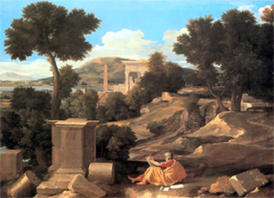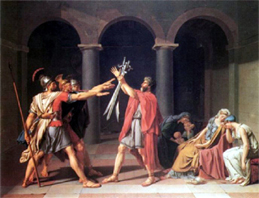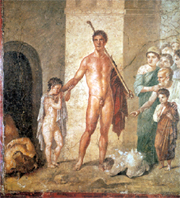 1
1Unlike Renaissance masters such as Botticelli and Raphael who foregrounded classical myth, seventeenth-century proto-Neoclassical painters used it as a narrative trope for the newly evolving and highly sought after genre of mytho-picturesque landscape painting. Poussin, Dughet and Claude as well as the Italian Salvator Rosa (1615-1673) re-establish a discourse between idealised nature and classical idealism almost entirely predicated upon the poetry of Horace, Virgil and Ovid and fragments of ancient wall-painting. The lure of Italy, as a latter day Elysium, was to a very large extent derived from idealised readings of these Latin poets, who became increasingly accessible due to the proliferation of ‘classical’ libraries. (see Coltman, V., 1999, Classicism in the English Library, Beckford Society Lectures, 2000-3) Their eulogies to sacro-idyllic and bucolic landscapes inhabited by redeeming heroes, became the topos for virtually every aspiring post-seventeenth century painter. And, since the work of these painters was based on a discourse underpinned by sacro-idyllic poetry and the picturesque, both Christians and humanists could engage with it. The melancholic mixture of Epicurean and Stoic virtues that they imbedded in their paintings became the emblematic trademarks of later Neoclassical artists such as Mengs, David and Ingres. The same Latin poets also influenced Roman wall-painting seventeen hundred years earlier largely as a result of Augustus's patronage. They provided the symbolic language which enabled him to achieve his political goals following his victory over Mark Antony and Cleopatra. This is best exemplified by the Ara Pacis, designed to symbolise the dawning of a new Golden Age of peace and prosperity. (see Castriota, David, 1995, The Ara Pacis Augustae and the Imagery of Abundance in Later Greek and Early Roman Imperial Art, Princeton.)
The fact that the Latin poets influenced both ancient and modern artists does not mean that these artists shared the same values. Far from it, the former were pagan and the latter Christian. The presence of St John in Poussin's landscape laden with classical references reminds us of this crucial difference (fig.1). Pagan painters lived in a world that was not too dissimilar to the narratives that they depicted. They inhabited a ritualised world in which every day life brought them into contact with their gods (fig.2). The cities and landscapes that surrounded them were mirrored in their paintings and both contained an abundance of shrines, temples, and sacro-idyllic groves that were thought to be the abodes of their gods. The Neoclassical painter, on the other hand, relied entirely upon a romantic vision predicated upon a literary topos. Despite this fundamental difference, the aesthetic values associated with Neoclassical painting became those associated with the newly discovered ancient wall-paintings from Pompeii and Herculaneum.
The ancient bucolic landscapes that signified Pagan Rome’s longing for its political and religious roots in agrarianism, were transformed into quaint pastoral charades by Neoclassicism. By the late eighteenth century, maidens and shepherds frolicking amongst the ruins of the Forum and Colosseum typified the melancholic passing of the Golden Age, especially if viewed by moonlight. Neoclassicism also reconfigured the sacro-idyllic grove into a place in which aristocracy could masquerade as satyrs, nymphs and maenads. In contrast, the sacro-idyllic vignettes that magically hover on Pompeian walls contain no such frivolous moonlight masquerades, only a somber reminder that the gods can only be placated by sacrificial worship (fig.3). The image of the classical hero was also appropriated by Neoclassicism, particularly in France, where its fledgling Republic used it to promote self-sacrifice for the good of the Republic (fig.4). In contrast to French pragmatism, heroes in Pompeian paintings were depicted fighting complex corporeal and metaphysical battles (fig.5).
 1
1 4
4 5
5